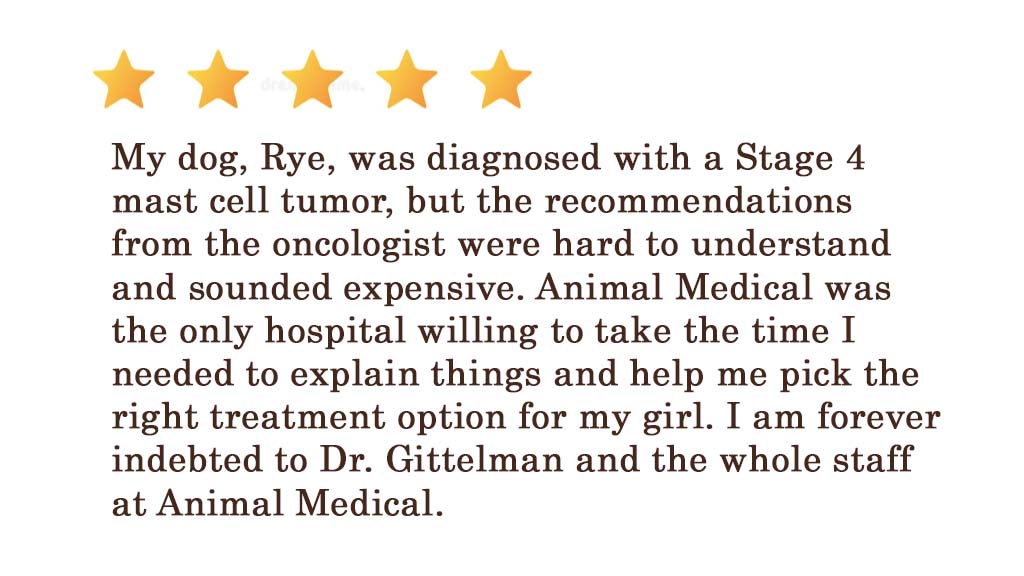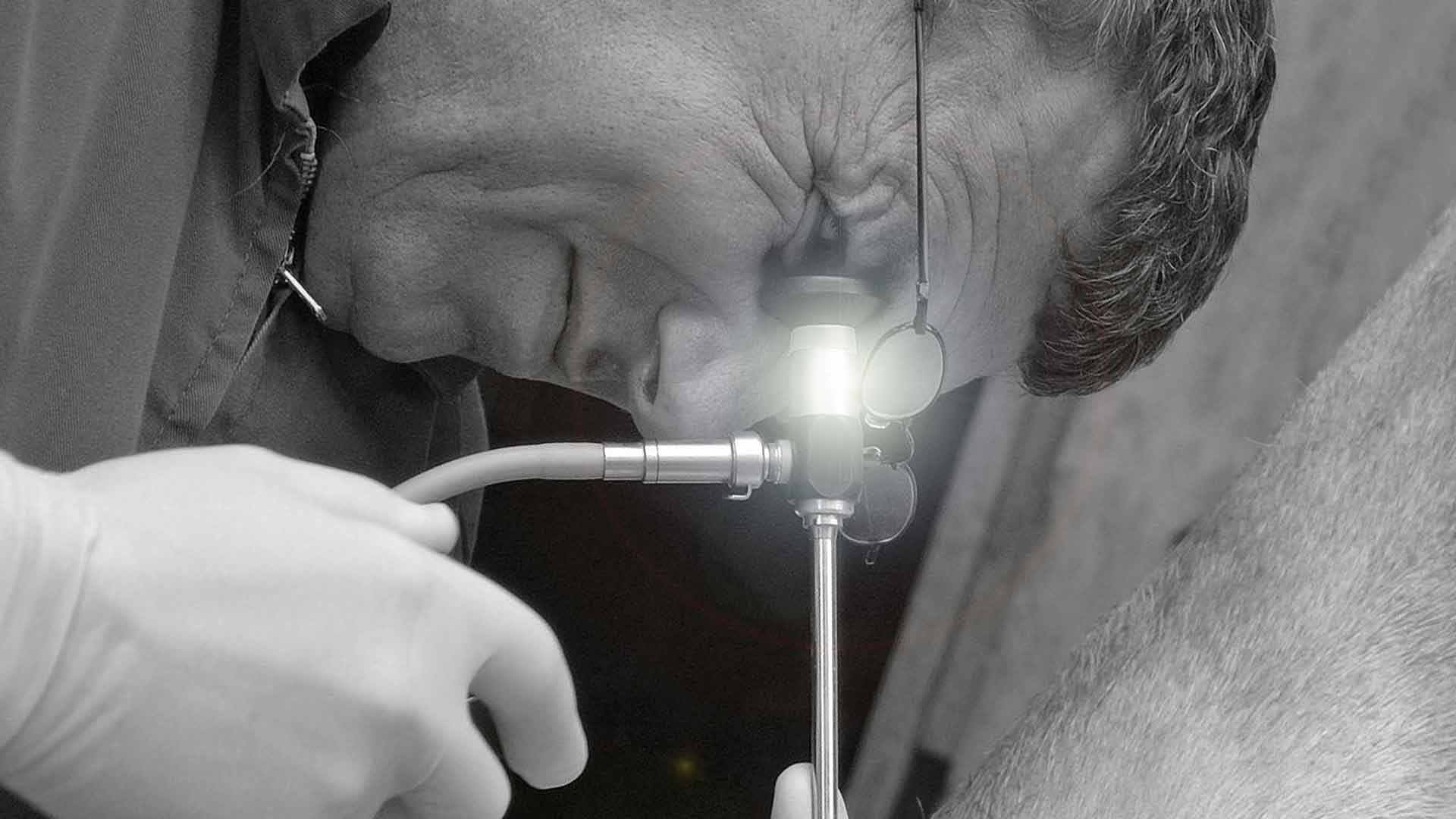Mast Cell Tumors in Cats and Dogs
10-20% of all skin growths are mast cell tumors. Non aggressive forms of this disease can be treated successfully with early diagnosis and surgery. If your pet has a lump or growth, or if your pet has recently been diagnosed with a mast cell tumor, this handout will be helpful
Jump to ‘What do mast cell tumors look like?’
Jump to ‘Are mast cell tumors common?’
Jump to ‘What breeds are most at risk?’
Jump to ‘What are the symptoms of mast cell disease?’
Jump to ‘How are mast cell tumors diagnosed?’
Jump to ‘What is the prognosis?’
Jump to ‘How are mast cell tumors treated?’
Jump to ‘How can I finance the care for mast cell disease?’

What is a mast cell tumor?
Mast cell tumors are cancerous tumors arising from mast cells, a kind of white blood cell that is part of your pet’s immune system. When they function properly, mast cells, rich in granules containing histamine and heparin (an anticoagulant), release their contents at sites where there is an allergen present. If you’ve ever watched a mosquito bite swell and turn red, you’ve seen the results of properly functioning mast cells. It is not known what causes mast cells to turn cancerous and to form tumors in dogs and cats.
What do mast cell tumors look like?
Though some veterinarians rule out the possibility of a mast cell tumor by the growth’s appearance and where it is located on the pet, the practice is not supported by science or data. Mast cell tumors are known as the great pretenders. They can appear as innocuous as an insect bite. Sometimes they arise and then disappear creating a false sense of hope that initial concern was unwarranted. They can look like raised, rubbery lumps on the skin, or can be located beneath the skin. They can appear reddish, whitish, smooth, or bumpy. If your pet has a skin growth, please have it evaluated by one of the veterinarians at Animal Medical of New City. We will guide you to the most affordable and efficient diagnostic options.
Are mast cell tumors common in dogs and cats?
Mast cell tumors account for 16-20% of all skin tumors in or on dogs and cats.
What breeds of dogs and cats are most at risk for mast cell disease?
Any dog or cat can acquire mast cell disease, but it is most commonly seen in Beagles, Boston Terriers, Rhodesian Ridgebacks, Boxers, Pugs and all kinds of Retrievers. In cats, the disease is often seen in the Siamese breed. Mast cells typically grow on the limbs of dogs and cats, especially on the rear of the thigh, and on the trunk of the animal, but they can show up anywhere including the top of the head and on the face of the pet.
Symptoms of Mast Cell Tumor Disease
Because mast cells are filled with histamine and heparin (an anticoagulant), mast cell tumors can cause surrounding tissue to swell, itch and bleed. In some cases, histamine released from the mast cells in tumors can cause lesions in the gastrointestinal tracts of animals and cause inappetence, vomiting, and changes to the appearance of a pet’s stool.
How are mast cell tumors diagnosed?
Fine Needle Aspirate
Veterinarians diagnose mast cell tumors by looking at the tumor’s cells under a microscope. Tumor cells are acquired in a process called fine needle aspiration. During this procedure, a small hypodermic needle is inserted into the mass and a nearly imperceptible amount of tissue is withdrawn. Your pet will not require any sedation for this procedure because the process is minimally invasive. Once the sample is acquired, it is placed on a microscope slide, stained, and observed under a microscope. Mast cells readily absorb stain and appear as light purple circles with more darkly stained, pepper-like grains . The presence of mast cells in the sample is a positive sign of mast cell tumor disease.
The Mast Cell Tumor Panel
Traditionally, it has been difficult to determine the aggressiveness of mast cell tumor cancers and long term prognostications for this disease have been fraught with inaccuracies. Today, we know that aggressive mast cell cancers have tell-tale signs of nucleic abnormality and intracellular signs of abnormal cell growth, both of which we have the technology to measure. The Mast Cell Tumor Panel, available through the Michigan State University, will assist veterinarians at Animal Medical of New City in providing you with an accurate long term prognosis for your pet.
Additional Diagnostics
If the mass is positive for mast cells, your veterinarian will likely order an ultrasound or radiograph of your pet’s chest and abdomen to look for more extensive signs of cancer. He or she may also order a complete blood count, a blood chemistry, and urine test all of which will help determine if the disease has progressed beyond the primary tumor.
What is the prognosis for a dog or cat that is diagnosed with a mast cell tumor?
The prognosis for a pet diagnosed with a mast cell tumor is determined by the ‘grade’ of the tumor (Grade 1, the tumor occurs on the skin; Grade 2, the tumor occurs on the skin and in some of the subcutaneous tissue with some signs of malignancy; Grade 3, the tumor is located below the skin); the number of tumors found on the pet, the aggressiveness of the cancer associated with the tumors; and the extent to which the disease has spread throughout the body. Typically mast cell tumor disease is diagnosed in four stages. According to the National Canine Cancer Foundation:
“Mast cell tumor is staged after it is surgically excised and examined, along with the surrounding lymph nodes. The factors on which staging depends include the number of tumors present and lymph node involvement.
Stage 0
One tumor in the skin incompletely removed, with no lymph node involvement.
Stage 1
One tumor in the skin, with no lymph node involvement.
Stage 2
One tumor in the skin with lymph node involvement.
Stage 3
Multiple large, deep skin tumors, with or without lymph node involvement
Stage 4
One or more tumors with metastasis in the skin with lymph node involvement. This stage is further divided into those that have no other signs (substage a) and those that have some other clinical symptoms (substage b).
“The outcome sorely depends upon histologic grade. Dogs with well differentiated tumors live longer after complete surgical excision. Dogs with undifferentiated lesions die within 1 year after surgery due to metastasis. Studies have suggested that patients with a single mast cell tumor (MCT) and those with multiple cutaneous MCTs have similar prognosis. Symptoms like anorexia, vomiting, melena, widespread erythema and edema associated with visceral forms of MCT have poor prognosis.
Therefore we can say that more aggressive treatment at the time of the first appearance of the disease rather than at the time of recurrence may improve the chances of prognosis.”
How are mast cell tumors on dogs and cats treated?
Provided that the cancer is localized and that the extent of the disease is limited, the first course of action is surgery to remove the tumor. Because mast cells are known to have a ‘halo’ of cancerous cells surrounding the tumor itself, veterinarians will remove the tumor with a 3 to 4 centimeter margin to reduce the chances of the tumor returning and /or spreading.
Based on the histopathology of the excised tumor (the evaluation of the removed tumor), the number of tumors, and the extent to which lymph nodes are involved, the veterinarians at Animal Medical of New City may recommend radiation therapy or chemotherapy in addition to the surgery to treat the disease
Patients may also receive steroid therapy as part of the their treatment.
My dog or cat has some skin growths, what should I do?
As we stated earlier, approximately 16-20% of all skin masses are mast cell tumors. The treatment for mast cell disease is straightforward and the prognosis is usually good provided that the cancer is not too aggressive and caught early. Please bring your pet it for an examination. We’ll be able to provide you excellent advice on what you should do to address your pet’s skin growths.
This video is a helpful summary of all that exists in this article.
What If I Can’t Afford Treatment?
Cancer treatment can be expensive. We have put together a resource that will help you understand your finance options.



